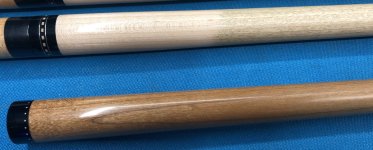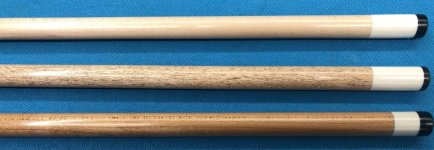I purchased a Kielwood shaft from Martin (Superiorcues.com) made by Cory Barnhart who refers to his shafts as roasted maple rather than Kielwood because of trademark reasons. Another thing that is very different is he only makes radial joint shafts so if you want a different thread you are out of luck. Aside from that, he makes a terrific Kielwood shaft and I can refer to it as such since the trademark doesn’t apply to me. CF shafts are not my cup of tea. Tried several and never fell in love with any but I sure do have a great romance taking place with my Barnhart shaft. Specs are: radial flat faced, 3.8 ozs, 12.85mm, extended pro taper……..I made sure to match the specs to the orig. Scruggs shaft I was leaving in my case since it’s my only radial joint cue. All my other playing cues have 3/8x10 and 3/8x11 threads and ivory joints.
The first thing I did was change the tip to match my other cues. It made a big difference and after doing that, my romantic connection with this shaft became a “torrid” love affair with my torrified Barnhart maple shaft. It feels wonderful and long distance shots on a 9’ table just aren’t as difficult anymore. The cue ball rolls straighter to my aim point and I can strike the cue ball with less velocity, even softly, and the cue ball rolls more straight than with my original Scruggs cue shafts. It is just a great shaft and I asked Cory if he’d make me a couple of more shafts for my other cues. Unfortunately, radial shafts is the only version he’s chosen to make so I need to find another cue maker who can duplicate the specs of my other cue shafts in a Kielwood version. I found out matching the shaft specifications of the cue shaft you are currently using is very important, at least for me. When I tried lighter Kielwood shafts, I didn’t care for them at all just like with CF shafts.
I am a firm advocate on the importance of maintaining proportional weight between the cue shaft & cue butt, whenever I played with a cue that didn’t meet a specific ratio, I’ve generally been disappointed with the way the cue plays, aside from maybe it having too hard of a tip. I also frown on the use of weight bolts unless it can be positioned in the butt and always less than 14 grams. (no more than 2 headless 7 gram weight bolts). If the cue maker can’t build a cue butt within a 1/2 oz. of my specified butt weight without exceeding it, I just don’t even order the cue. My last cue Bob Owen made was ordered to have a 14.5 ozs butt weight (sans weight bolt). My cue butt weighs 14.564 ozs.
Great cue makers can produce cues and shafts that are marvelous and far superior to what others make. For some reason, and I don’t know why, Cory Barnhart’s roasted maple shafts play better than any other CF or Kielwood shafts I’ve tried. If you have a radial shaft you were ever thinking or replacing with a low defection shaft but wanted the feel and look of wood, Martin still had a few Barnhart RMS available. When I am at the pool hall later today, I’ll take some photos but pretty much everyone knows what a Kielwood shaft looks like. The fit of the shaft (.840) on my Scruggs cue is seamless too. I’m telling you kiln roasting a maple shaft changes it’s properties enormously….if you are ready to make a change, just contact Martin.
The first thing I did was change the tip to match my other cues. It made a big difference and after doing that, my romantic connection with this shaft became a “torrid” love affair with my torrified Barnhart maple shaft. It feels wonderful and long distance shots on a 9’ table just aren’t as difficult anymore. The cue ball rolls straighter to my aim point and I can strike the cue ball with less velocity, even softly, and the cue ball rolls more straight than with my original Scruggs cue shafts. It is just a great shaft and I asked Cory if he’d make me a couple of more shafts for my other cues. Unfortunately, radial shafts is the only version he’s chosen to make so I need to find another cue maker who can duplicate the specs of my other cue shafts in a Kielwood version. I found out matching the shaft specifications of the cue shaft you are currently using is very important, at least for me. When I tried lighter Kielwood shafts, I didn’t care for them at all just like with CF shafts.
I am a firm advocate on the importance of maintaining proportional weight between the cue shaft & cue butt, whenever I played with a cue that didn’t meet a specific ratio, I’ve generally been disappointed with the way the cue plays, aside from maybe it having too hard of a tip. I also frown on the use of weight bolts unless it can be positioned in the butt and always less than 14 grams. (no more than 2 headless 7 gram weight bolts). If the cue maker can’t build a cue butt within a 1/2 oz. of my specified butt weight without exceeding it, I just don’t even order the cue. My last cue Bob Owen made was ordered to have a 14.5 ozs butt weight (sans weight bolt). My cue butt weighs 14.564 ozs.
Great cue makers can produce cues and shafts that are marvelous and far superior to what others make. For some reason, and I don’t know why, Cory Barnhart’s roasted maple shafts play better than any other CF or Kielwood shafts I’ve tried. If you have a radial shaft you were ever thinking or replacing with a low defection shaft but wanted the feel and look of wood, Martin still had a few Barnhart RMS available. When I am at the pool hall later today, I’ll take some photos but pretty much everyone knows what a Kielwood shaft looks like. The fit of the shaft (.840) on my Scruggs cue is seamless too. I’m telling you kiln roasting a maple shaft changes it’s properties enormously….if you are ready to make a change, just contact Martin.




